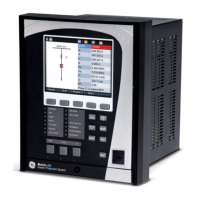4–378 850 FEEDER PROTECTION SYSTEM – INSTRUCTION MANUAL
CONTROL CHAPTER 4: SETPOINTS
While RIP is active, the scheme checks that the breaker opens and the shot number is
below the limit; it then begins measuring the dead time.
A fault occurs resulting in an Overcurrent element tripping the circuit breaker and initiating
a reclosure. Once the breaker is detected open a ‘dead timer’ is started. Once this timer
exceeds the value programmed for the AR1 DEAD TIME 1 setpoint and the additional timer
exceeds the value programmed for the AR1 DELAY (AR1 ADD DELAY has to be ON), the shot
counter is incremented and a breaker closure is initiated using the ‘Close’ output #2
contact. At the same time, the Overcurrent element characteristics are modified (blocking
or increasing Pickup) according to the Reclosure 1 setpoints.
If the fault is permanent, subsequent Overcurrent element(s) Trip and initiate Reclose. The
scheme eventually goes to Lockout when the AR1 MAXIMUM NUMBER SHOTS has been
reached and another Trip occurs. If a breaker failure condition is detected at any time
during operation, the scheme goes straight to Lockout. When in Lockout, the 850
disables
the Reclose scheme and returns all protection setpoints to their initial values. To re-enable
the Autoreclose scheme, the Lockout must be reset via manual reset (including front panel,
communication, FlexLogic), by AR1 RST LOCKOUT ON MANUAL CLS or by AR1 RST LOCKOUT
IF BKR CLOSED (after AR1 RST LOCKOUT DELAY times out).
If the fault is transient in nature then no Overcurrent element(s) operate after the breaker
has closed. The scheme automatically resets when the reset timer, started upon the first
Reclosure initiation, exceeds the AR1 RESET TIME setpoint value. This Autoreclosure reset
returns the shot counter to zero.
Each of the four possible shots has an independently settable dead time. One additional
timer can be used to increase the initial set dead times 1 to 4 by a delay equal to AR1
DELAY. This offers enhanced setting flexibility using FlexLogic operands to turn the
additional timer “on” and “off”. These operands may possibly include AR1 SHOT CNT n,
SETTING GROUP 1 ACTIVE, etc. The Autoreclose provides a maximum of 4 selectable shots.
Maximum number of shots can be dynamically modified through the settings AR1 REDUCE
MAXIMUM TO 1 (2, 3), using the appropriate FlexLogic™ operand or automatically by the
Current Supervision function.
Scheme Lockout blocks all phases of the reclosing cycle, preventing automatic reclosure, if
any of the following occurs:
1. The maximum shot number was reached.
2. A ‘Block/Cancel’ input or Breaker Failure are in effect (for instance - external breaker
failure, bus differential protection operated, etc.) while AR is in progress.
3. The ‘Incomplete Sequence’ timer times out.
4. AR1 Coordinating Lockout.
5. AR1 Rate High Lockout.
The Recloser is latched in the Lockout state until a ‘Reset from Lockout’ signal is asserted,
either from a manual close of the breaker, a reset if breaker is closed, or from a manual
reset command (local or remote). The ‘Reset from Lockout’ can be accomplished by
operator command, by manually closing the breaker, or whenever the breaker has been
closed and has stayed closed for a preset time.
After the dead time elapses, the scheme issues the CLOSE signal. The CLOSE signal is
latched until the breaker closes or the scheme goes to Lockout. A reset timer output resets
the Recloser following a successful Reclosure sequence. The reset time is based on the
breaker ‘reclaim time’ which is the minimum time required between successive Reclose
sequences.
Path: Setpoints > Control > Autoreclose 1(X)

